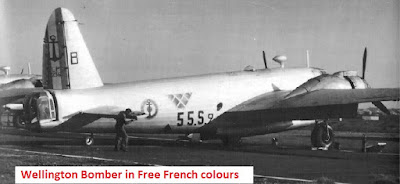LEADGATE REMEMBERS at this special time of year, four brave Free French Airmen who died at Bunker Hill Leadgate on Friday 26th May 1944.
Rene Richard – Raoul Blot - Jean-Lucien Fischbach - Alexander Ponton
After the fall of France in June 1940 French airmen started to form units with the backing of the British and later the USA in The Middle East and Africa where bits of the French empire had been. As the war went on units flew in the war in North Africa and Italy, and one squadron flew from the Soviet Union. In the UK several Squadrons of the RAF were set up consisting mainly of Free French airmen.
In May 1944 the first of two bomber squadrons of Free French were formed at RAF Elvington, York. These were 346 “Guyenne” Squadron and later 347 “Tunisie” Squadron. Most of the aircrew had been serving in North Africa until 1943 before transferring to Britain as part of Bomber Command. At its height there was some 2000 French aircrew based there.
The airmen were sent to RAF Lossiemouth in the north of Scotland for training. There they worked with No 20 Operational Training Unit (George Cant from Leadgate had died earlier in the war flying with the unit in 1942).
On 25th May 1944 one crew set off from Lossiemouth on a night exercise flight in Wellington X ME553, JM-F. The crew were Capt. Rene Richard the pilot. Lt Raoul Blot navigator, S/Lt Alexander Ponton bomb aimer, Sgt Jean Fischbach wireless operator. Lt Jean Vles navigator, Sgt Guy Soury-Lavergne air gunner, and Sgt Gilbert Allain air gunner.
During the flight they encountered severe icing at 15000ft.They descended to 7000ft but it did not improve and they were all ordered to prepare to abandon the aircraft. . Before anyone did the captain felt a slight improvement in the Wellington’s handling and at about 1.00 am on Friday 26th May attempted a force landing at what he thought was an airfield. In fact he came down in a field at Bunker Hill farm in Leadgate. In the crash landing and subsequent fire Richard, Blot, Fischbach, and Ponton died.
The four killed were buried at Harrogate Cemetery on May 30, 1944, by the RC Padre, the bearded and pipe smoking Father Meurisse.
Rene Richard was born on 16th October 1907 at Altkirch in Alsace Northeast France. At the end of the war he was reburied at Brookwood Military Cemetery with over 240 other Free French Airmen.
Raoul Constant Valentin Blot was born on 22nd July 1917 in Evron in Normandy. At the end of the war his body was also moved to Brookwood Military Cemetery in Surrey.
Jean-Lucien Fischbach was born in
Reims in Northern France on 6th December 1921. He was originally buried at
Harrogate and after the war his body was repatriated to France
Alexander Ponton was born on 14th
March 1917 in Antananarivo the capital of Madagascar. . He was originally
buried at Harrogate and after the war his body was repatriated to France.
The three survivors had mixed fortunes:
Jean Claude Vles was born 12th February 1915 in Paris. Once he had recovered from the crash at Leadgate he returned to Elvington and 346 Squadron. Sadly he was shot down near Bochum in Germany near Dortmund on 4th November 1944 as part of the crew of Halifax III NA558. His father Fred Vles was a professor at Strasbourg University who was sent with many other academics to Dachau where he died on 2nd July 1944.
Gilbert François ALLAIN was born in Nantes in France 15th October 1916. He lived on after the war and died 2nd March 1983 at Hyres near Toulon in southern France.
Guy Marie Soury-Lavergne was born the
13th June 1921
at in Canada. When he recovered from his injuries in Leadgate he
returned to RAF Elvington and became a part of 347 Squadron. On 2nd November
1944 he was the rear gunner on Halifax III LW443 which was shot down on a raid
on Dusseldorf, just over the Belgian/German border. He was ordered to bail out
and managed to evade the Germans for five days and nights to escaped back to
Allied held territory. He re-joined his squadron and flew another 20 missions.
After the war he went first to Madagascar and later to Indochina as a
navigator. He then moved to Limoges where he one of the pillars of the Limousin
Aero-club. He died on 10th August 2010 in Limoges.
You can find out more about the Free French Air Force and Elvington at these sites and others.
https://yorkshireairmuseum.org/.../french-squadrons-in.../
https://www.youtube.com/watch?v=BOcILWnh0TE
https://tailendcharlietedchurch.wordpress.com/.../raf.../
There is no memorial to these four brave Frenchmen who died in our village, not do they appear on our war memorial.
Today Poppy Crosses with 'Le Bleuet de France' Cornflowers have been placed at our War Memorial to remember the four and their comrade Jean Claude Vles who died later in 1944.









